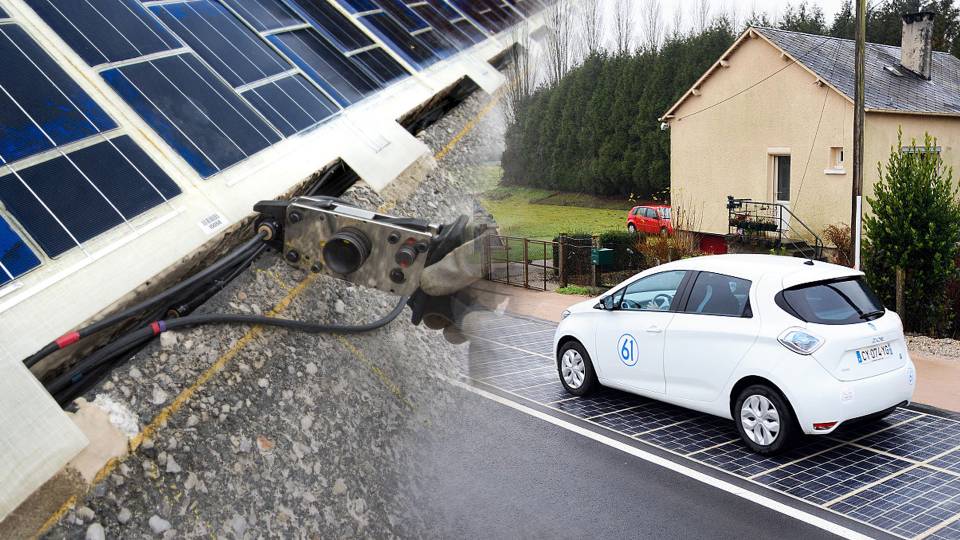World’s first solar road opens in France: It’s ridiculously expensive
Kilometer-long road cost $5.2 million to build.
The world's first solar highway has been opened in France, in the not-very-sunny village of Tourouvre au Perche in Normandy. The roadway is just one kilometre (0.6mi) long, but that still works out at 2,800 square metres of photovoltaic cells—enough, hopefully, to power the village's street lights.
The road was built by Colas, a large Anglo-French construction company. Colas has apparently been working on its own solar road tech, called Wattway, for at least five years. Wattway has been tested in car parks, but this is the first time it has been used on an active road. There will now be a two-year test period, to see if Wattway can withstand the rigour of being pounded by thousands of cars and trucks per day, and whether it can actually provide a useful amount of electricity.
Usefulness aside, the main problem with constructing solar roads is their crippling cost. One of the main selling points of Wattway, according to Colas, is that each panel is just a few millimetres thick, and can thus be installed on top of an existing road, which in turn massively reduces construction costs. Having said that, the 1km road in Normandy cost €5 million (£4.3m) to build. And that's for a single lane of a two-lane highway!
Expanding that out to €10m per kilometre for a two-lane solar road, you're looking at a total cost measured in billions or even trillions of pounds to cover a sizeable portion of a country's roads with solar panels. France has over a million kilometres of roads; the US has over 6 million. And that's not counting the larger highways with more than two lanes...
Fortunately, Ségolène Royal, France's ecology minister, has a much more reasonable goal in mind: she would like to see solar roadways replace one kilometre of every 1000 in France. Again, assuming she means two-lane solar roads at around €10 million per kilometre, the total cost would be €10 billion—not bad, assuming the panels (and the accompany electrical system) don't need regular maintenance, and that they produce enough electricity to be worth the much higher initial outlay.
Indeed, their questionable efficiency is one of the main reasons that more solar roads aren't currently being built. Colas says that Wattway's photovoltaic efficiency is 15 percent, which is pretty good (commercial panels that you might put on your roof are at about 20 percent). But that doesn't take into account the fact that the solar panels are flat on the ground, rather than angled towards the sun's trajectory, significantly reducing efficiency at higher latitudes. Heavy traffic could also block sunlight; as could snow, mud, and perhaps standing water after rain.
Back in 2014, a 70-metre solar bicycle path was built in the suburbs of Amsterdam in the Netherlands, at the utterly insane cost of €3 million. In its first year it produced about 3,000 kilowatt-hours (kWh) of electricity—enough to power an average home. At the current wholesale price in the UK (about £40 per megawatt-hour), that same €3 million would've bought you about 65,000,000 kilowatt-hours of electricity, enough to power about 21,000 homes for a year.
Obviously the maths are a bit better on the €5 million road in Normandy, but that's still an awful lot of money to spend on powering the village's (population ~3,300) street lights. The Wattway brochure suggests that 2,800 square metres of solar roadway ought to be able to power about 140 homes—about 420MWh per year. Though clearly, if they are just looking to power the village's street lights, they're not expecting anywhere near 420MWh in reality—perhaps due to the low amount of direct sunlight in Normandy.
Finally, because it's Christmas and there's no one in the office to stop me being mean, let's talk about Solar Roadways, an Indiegogo project that raised a ridiculous sum of money ($2.2 million) back in 2014. That money, according to Solar Roadways, is being spent "on engineers to help us make a few needed tweaks in our product and streamline our process so that we could go from prototype to production.” Two years later, the first public installation of Solar Roadways is finally being constructed at a Route 66 welcome centre in Missouri.
According to the Missouri department of transport (MoDOT), the small 12ft-by-20ft patch of solar road will cost $100,000 to install. That works out at $416 per square foot—about $4,500 per square metre, or $11.6 billion per square mile. Scott Brusaw, founder of Solar Roadways, says there's about 29,000 square miles of paved roads in the lower 48 US states, and he'd like to turn most of them into solar roads. He'll need one hell of a Kickstarter to raise $330 trillion—16 times the US national debt—though.
Personally, I think Brusaw's efforts would be better focused on just building a Dyson sphere and solving all of humanity's energy issues in one fell swoop.






















